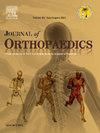Intraoperative tranexamic acid reduces postoperative haemarthrosis and improves early functional outcomes in double-bundle anterior cruciate ligament reconstruction
IF 1.5
Q3 ORTHOPEDICS
引用次数: 0
Abstract
Introduction
Double-bundle anterior cruciate ligament reconstruction (ACLR) has biomechanical advantages but is associated with increased intraoperative bleeding. The role of tranexamic acid (TXA) in reducing postoperative joint haemarthrosis and improving the short-term outcomes of double-bundle ACLR has not yet been thoroughly investigated. This study aimed to assess the effects of intraoperative TXA on postoperative joint haemarthrosis and short-term functional outcomes in patients who underwent double-bundle ACLR.
Methods
This retrospective cohort study included 80 male patients who underwent double-bundle ACLR between January 2019 and December 2022. The patients were divided into two groups: those who received TXA and those that did not. The TXA group received 50 mL of TXA (10 mg/mL) intravenously approximately 10 min before tourniquet release, followed by an intra-articular injection of 50 mL TXA (10 mg/mL) immediately after wound closure, prior to tourniquet release, whereas the control group did not receive TXA. Primary outcomes included postoperative haemarthrosis volume, assessed using Coupens and Yate (CY) values; and short-term functional recovery, evaluated using range of motion (ROM), quadriceps strength, and visual analogue scale (VAS) pain scores on day 1, day 15, week 6, and week 12 postoperatively.
Results
Intraoperative administration of TXA in patients undergoing double-bundle ACLR reduced postoperative haemarthrosis, as measured by a lower CY value on postoperative day 1 (P = 0.004) and day 15 (P < 0.001). Compared to patients in the control group, patients in the TXA group reported lower VAS pain scores on day 1 (P < 0.001), day 15 (P < 0.001), and week 6 (P = 0.028), together with improved quadriceps strength (P = 0.043, day 1; P = 0.009, day 15) and ROM (P < 0.001, 12 weeks postoperatively) during the early postoperative period.
Conclusion
The use of TXA during double-bundle ACLR may reduce postoperative joint haemarthrosis and enhance short-term functional outcomes.
术中氨甲环酸可减少双束前交叉韧带重建术后的关节出血并改善早期功能。
双束前交叉韧带重建(ACLR)具有生物力学优势,但与术中出血增加有关。氨甲环酸(TXA)在减少双束ACLR术后关节血肿和改善短期预后中的作用尚未得到深入研究。本研究旨在评估术中TXA对双束ACLR患者术后关节血肿和短期功能结局的影响。方法:本回顾性队列研究纳入了2019年1月至2022年12月期间接受双束ACLR治疗的80例男性患者。患者被分为两组:接受TXA治疗的和未接受TXA治疗的。TXA组在止血带释放前约10分钟静脉注射50ml (10mg /mL) TXA,然后在伤口愈合后立即在止血带释放前关节内注射50ml (10mg /mL) TXA,而对照组不接受TXA。主要结局包括术后关节血肿量,用Coupens和Yate (CY)值评估;术后第1天、第15天、第6周和第12周,使用活动度(ROM)、股四头肌力量和视觉模拟评分(VAS)疼痛评分评估短期功能恢复。结果:双束ACLR患者术中给予TXA可减少术后关节出血,术后第1天CY值较低(P = 0.004),术后第15天CY值较低(P)。结论:双束ACLR患者术中使用TXA可减少术后关节出血,提高短期功能预后。
本文章由计算机程序翻译,如有差异,请以英文原文为准。
求助全文
约1分钟内获得全文
求助全文
来源期刊

Journal of orthopaedics
ORTHOPEDICS-
CiteScore
3.50
自引率
6.70%
发文量
202
审稿时长
56 days
期刊介绍:
Journal of Orthopaedics aims to be a leading journal in orthopaedics and contribute towards the improvement of quality of orthopedic health care. The journal publishes original research work and review articles related to different aspects of orthopaedics including Arthroplasty, Arthroscopy, Sports Medicine, Trauma, Spine and Spinal deformities, Pediatric orthopaedics, limb reconstruction procedures, hand surgery, and orthopaedic oncology. It also publishes articles on continuing education, health-related information, case reports and letters to the editor. It is requested to note that the journal has an international readership and all submissions should be aimed at specifying something about the setting in which the work was conducted. Authors must also provide any specific reasons for the research and also provide an elaborate description of the results.
 求助内容:
求助内容: 应助结果提醒方式:
应助结果提醒方式:


